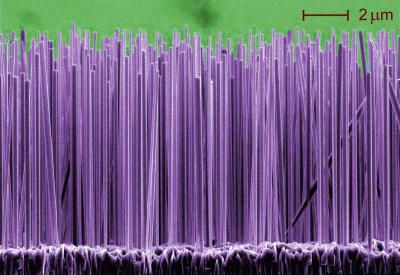Technorati Tags: Nanofibers or Nanotubes and Nano or Nanotechnology and nanoparticles or Nanotech and Nanopore or nanochemistry and nanoscale or nanowires and light-emitting diodes or nanometrology and lasers or Nanolight and nanostructures or Nanoscience
 | The nano world is getting brighter. Nanowires made of semiconductor materials are being used to make prototype lasers and light-emitting diodes with emission apertures roughly 100 nm in diameter-- |
Researchers at the National Institute of Standards and Technology (NIST) are growing nanowires made of gallium nitride alloys and making prototype devices and nanometrology tools. The wires are grown under high vacuum by depositing atoms layer by layer on a silicon crystal. NIST is one of few laboratories capable of growing such semiconductor nanowires without using metal catalysts, an approach believed to enhance luminescence and flexibility in crystal design. The wires are generally between 30 and 500 nanometers (nm) in diameter and up to 12 micrometers long. When excited with a laser or electric current, the wires emit an intense glow in the ultraviolet or visible parts of the spectrum, depending on the alloy composition.
A paper in the May 22 issue of Applied Physics Letters* reports that individual nanowires grown at NIST produce sufficiently intense light to enable reliable room-temperature measurements of their important characteristics. For example, the peak wavelength of light emitted with electric field parallel to the long axis of a nanowire is shifted with respect to the peak wavelength emitted with electric field perpendicular to the wire. Such differences in emission are used to characterize the nanowire materials and also may be exploited to make sensors and other devices.
NIST has grown a variety of nanowires and extensively characterized their structural and optical properties, finding few defects, strains or impurities, which results in high light output compared to the bulk material.** The wires also can be transferred from the silicon crystal to other substrates, such as sapphire, and arranged using electric fields. The NIST team has used the nanowires to make a number of prototype devices, including light-emitting diodes, field-effect transistors, and nanowire "bridge" structures that may be useful in sensors and nanoscale mechanical resonators. ###
*J.B. Schlager, N.A. Sanford, K.A. Bertness, J.M. Barker, A. Roshko and P.T. Blanchard. 2006. Polarization-resolved photoluminescence study of individual GaN nanowires grown by catalyst-free MBE. Applied Physics Letters. May 22.
** K.A. Bertness, N.A. Sanford, J.M. Barker, J.B. Schlager, A. Roshko, A.V. Davydov and I. Levin. 2006. Catalyst-Free Growth of GaN Nanowires. Journal of Electronic Materials 35, 576. April.
Contact: Laura Ost laura.ost@nist.gov 301-975-4034 National Institute of Standards and Technology (NIST)
Related: Keyword Nanotech Sunday, Sunday, May 14, 2006 Scientists Create the First Synthetic Nanoscale Fractal Molecule, Sunday, May 14, 2006 World’s tiniest test tubes get teensiest corks, Sunday, May 07, 2006 Blood-Compatible Nanoscale Materials Possible Using Heparin, Sunday, April 30, 2006 Micro-pump is cool idea for future computer chips, Sunday, April 16, 2006 Self-Powered Nanoscale Devices, Sunday, April 09, 2006 Nanopore Method Genome Sequencing, Sunday, April 02, 2006 Quantum dot method rapidly identifies bacteria, March 26, 2006 'Custom' nanoparticles, cancer diagnosis and treatment, Sunday, March 26, 2006, Green nanochemistry, American Chemical Society symposium, Sunday, March 19, 2006 nanotechnologists demonstrate artificial muscles powered by highly energetic fuels, Sunday, Sunday, March 12, 2006 magnetic phenomenon may improve RAM memories, February 26, 2006 Nanoscience study shows that quantum dots 'talk', Sunday, February 26, 2006 Nano-bots to undertake major tasks?, Sunday, February 19, 2006 Nanotech to improve health care delivery, Sunday, February 19, 2006 nano-canary in the nanotoxicology coalmine, Sunday, December 04, 2005 Nano-cages 'fill up' with hydrogen, Sunday, November 13, 2005 Testing toxicity of nanomaterials, Sunday, October 23, 2005 single-molecule car, 'Nanocar', Sunday, August 28, 2005 Writing at the nanoscale, Thursday, May 26, 2005 discontinuous palladium, siloxane self-assembled monolayer, Sunday, May 08, 2005 Center for Nanoscale Materials, Monday, April 25, 2005 Nanomagnets, Nanocomposite, Monday, March 21, 2005 porphyrin tubes may lead to new nanodevices, inexpensive hydrogen fuel.











No comments:
Post a Comment